Determination of drying kinetics, specific energy consumption, shrinkage, and colour properties of pomegranate arils submitted to microwave and convective drying
Abstract
In this study, the drying kinetics, effective moisture diffusivity (D eff), specific energy consumption (SEC), colour, and shrinkage (S b) of pomegranate arils were compared when dried by convective (CV) drying and microwave (MW) drying. The experiments were performed at air temperature of 50, 60, and 70°C and air velocity of 1 m/s for CV drying and 270, 450, and 630 W for MW drying. The results showed that increasing air temperature and MW power increased the D eff. The calculations demonstrated that the maximum D eff for pomegranate arils was obtained for MW drying (630 W). Maximum SEC for pomegranate arils in the CV dryer was 145.12 kWh/kg, whereas in the MW dryer was 35.42 kWh/kg. In MW dryer, the lowest values of colour change and shrinkage were 6.77 and 50.5%, respectively. Comprehensive comparison of the different drying methods (MW and CV) revealed that MW drying had best drying performance for pomegranate arils, considering the drying time, effective moisture diffusion, SEC, colour, and shrinkage.
1 Introduction
Pomegranate (Punica granatum L.) is one of the most important fruits in the subtropical regions, which is cultivated for its nutritional and therapeutic value (Galaz et al. 2017). Drying process, in addition to being a way to increase the shelf life of foods, is known as a way to increase the added value of food products. Under controlled conditions, removing water from a food product reduces its moisture content (MC) to a certain extent, which diminishes the activity of enzymes, the rate of undesirable chemical changes and microbial growth. In addition, the decrease in moisture is accompanied by a reduction in volume and weight, which is one of the important factors for transportation and storage (Sakare et al. 2020).
Throughout the decades, convective (CV) drying has been one of the most long-established technologies in the food industries. This includes both the heat and mass transfer while the water is extracted from the agricultural products through diffusion and evaporation (Castro et al. 2018).
One of the methods that has been given a lot of attention during the last decade is the use of microwave (MW) radiation in the drying process. MW beams are electromagnetic beams with a long wavelength (2.45 GHz). When these waves pass through the tissues, polar molecules, such as water and salts, vibrate, and this vibration causes the MW energy to be converted into heat. Other mechanisms are also involved, such as transportation of ions, which contribute to the generation of heat inside the sample. Unlike other drying methods, in which heat should penetrate from the surface to depth, in this method heat is produced in the tissue of the food itself, and, therefore, it causes minimal damage to the surface of the food (Kumar et al. 2020; Rattanadecho and Makul 2016). Among the advantages of MW drying are the fast volumetric heating and consequent fast drying rate and short drying time; enhanced quality of the product; reduced energy consumption that allows saving energy; and lower operating costs. Nevertheless, some disadvantages were also identified for the MW drying, such as high equipment investment on an industrial scale; potential quality loos, particularly in what concerns aroma, texture and other sensory characteristics; or the fact that specific sample size and shape may be needed to make the drying process effective (Orsat et al. 2006).
Different methods are used to reduce the MC of fruits and vegetables. Cuccurullo et al. (2019) used MW, CV, and MW–CV dryers to dry apple. They showed that MW–CV dryers led to lower drying rates when compared with the other methods investigated. Jebri et al. (2019) investigated the effect of different drying methods (MW and CV) on weight loss and rehydration of Salvia officinalis L. leaves. Drying of garlic puree by CV (50, 60, and 70°C) and MW drying (180, 360, and 540 W) was studied by İlter et al. (2018) to determine the drying behaviour. The results showed that the temperature of 70°C and the MW power of 540 W had the lowest variations in colour. In addition, the highest effective moisture diffusivity (D eff) was 3.7 × 10−10 and 285 × 10−10 m2/s at 70°C and 540 W, respectively.
As dried pomegranate arils are produced for consumption as an alternative to the fresh form, because of the higher preservation capacity and concentrated flavour and aroma, the interest for the drying kinetics of the arils is very relevant from the industrial point of view to optimize drying conditions and energy saving. There is still a lack of knowledge about this topic, as seen by the scientific literature published. Although there have been a few recent studies about the drying kinetics of pomegranate peel (Galaz et al. 2017; Kaderides et al. 2019; Mphahlele et al. 2019), only one study evaluated the drying kinetics of the arils (Kingsly and Singh 2007), and this was performed more than a decade ago and focused only on the CV drying, and just testing a few thin layer models, without evaluating relevant aspects other than the plain kinetic equations, such as for example diffusivity or specific energy consumption (SEC) analysis. Therefore, this study aims to bring new knowledge into the drying of pomegranate arils by comparing the drying of the product by two different methods: CV thin layer and MW drying. Furthermore, besides the estimation of the parameters of the drying equations, other technological aspects were also investigated, namely D eff, activation energy, and SEC. Finally, the product’s qualitative properties colour and shrinkage were evaluated for the arils dried using CV (in the range from 50 to 70°C) and MW drying (in the range from 270 to 630 W).
2 Materials and methods
2.1 Sample preparation
Pomegranate was supplied by one of the pomegranate orchards of Sardasht city, Iran, in October 2019. Generally, pomegranate aril samples of uniform size were selected. The pomegranate arils were cleaned and stored in a refrigerator at 4 ± 1°C. The premature and spoiled pomegranate fruits were separated manually. The initial MC of pomegranate was measured by oven drying method. A sample batch of pomegranate arils in triplicate essays were dehydrated at 70 ± 1°C for 24 h (Alaei and Chayjan 2015). Pomegranate arils with average initial MC of 70.25 ± 0.50% (wet basis), corresponding to 2.36 g/g dry solids, were selected for drying experiments. About 40 g of pomegranate arils was used for each of the drying experiments. The weight of the samples was measured by a digital balance, and recorded in time intervals of 10 min. The drying experiments of pomegranate arils continued until the MC of the samples reached about 0.1 (dry basis) in both drying methods.
2.2 Drying apparatus
2.2.1 CV dryer
CV drying was conducted using a laboratory drying oven (BF55E; FG Co., Iran). The inside air velocity close to the pomegranate samples was measured by an anemometer (Lutron AM-4202; Electronic Enterprise Co., Taipei, Taiwan), and the average air velocity was 1.00 ± 0.02 m/s. The electrical heating unit of this dryer is equipped with a PT100 thermometer sensor and a PID controller with ±0.1°C accuracy. The air temperature and relative humidity (RH) have been measured for the laboratory ambient. Therefore, during the experiments of CV drying, air temperature of ambient has been recorded as 26°C using a thermometer with type K (NiCr–Ni) thermocouple sensor and accuracy of ±0.1°C (Lutron TM-903, made in Taiwan) as well as air RH of ambient has been obtained 30% by a hygrometer with accuracy of ±3% RH (Lutron TM-903, made in Taiwan). Therefore, on average, during the CV dryings, average ambient air humidity and temperature were 30% and 26°C, respectively.
2.2.2 MW dryer
A fully programmable MW oven (Panasonic NN-CD997S Microwave Oven) with maximum output of 1,000 W was used in the experiments. The MW oven has the capability of operating at different MW output powers: 90, 180, 270, 360, 450, 540, 630, 720, 900, and 1,000 W. The area of the MW oven is 462 × 242 × 412 mm inner size and includes a 380 mm diameter rotary glass plate at the oven base. The MW output power and processing time were set fully using the oven digital control panel. The experiments of MW drying were carried out individually, and there was no control for measuring humidity inside the MW chamber during drying process because a local MW was used for the experiments. The power levels were the input parameters for MW drying process. The measurement of weight was done manually in the specific intervals during the drying experiments.
2.3 Experimental setup
2.3.1 Determination of MC and moisture ratio
Drying curves may be represented in different ways: MC at wet or dry basis versus time (t), drying rate versus time, or drying rate versus MC. The MC considered in the present study was the dry basis MC (M). Both M and moisture ratio (MR) of pomegranate arils were calculated using equations (1) and (2), respectively (Jebri et al. 2019):
where m 0, m v, and m dm are the initial mass, the mass of vapour (evaporated moisture), and the dry matter, respectively (g). In addition, M 0, M t, and M e represent the dry basis MC at time zero, time t, and equilibrium, respectively (kg water/kg dry matter).
It should be noted that, according to Süfer and Palazoğlu (2019), because usually the value of M e is very low compared with M t and M 0, then it can be considered not relevant for the calculation of the MR, and in that case equation (2) can be simplified to equation (3), which was used in the present work for the determination of the MR values:
2.3.2 Mathematical modelling of drying curves
To analyse the data for the drying curves obtained in the experimental essays, appropriate fitting equations were used. The models listed in Table 1 were used for the mathematical modelling of drying kinetics of pomegranate arils in CV and MW dryers. The CurveExpert software (version 1.4) was used to fit the equations in Table 1.
Empirical mathematical models for drying kinetics
| Models | Equation | References |
|---|---|---|
| Page |
|
Ashtiani et al. (2018) |
| Aghbashlo |
|
Kayran and Doymaz (2017) |
| Wang and Singh |
|
Agbede et al. (2020) |
| Logarithmic |
|
Jebri et al. (2019) |
| Two-term |
|
İlter et al. (2018) |
To select the suitable drying kinetics descriptor, the statistical parameters of coefficient of determination (R
2), root mean square error (RMSE), and chi-square (
In these equations, MRexp,i and MRpre,i are the experimental and predicted values of moisture ratio for a number of observations N, and z represents the number of model parameters.
2.3.3 Effective moisture diffusivity
Mass transfer during food drying is a complex process involving various mechanisms such as: molecular penetration, movement in capillary tubes, and liquid penetration in the porous materials, penetration of vapour in air pores and hydrodynamic flow, or surface propagation. Moisture penetration is one of the most important factors controlling the drying process. When different mechanisms are effective in transmission processes, it is difficult to examine each mechanism and measure the mass transfer rate in each one. In such processes, the description of effective diffusion is described by the Fick’s second law as follows (Agbede et al. 2020):
where D eff is the effective moisture diffusivity (m2/s), M is the dry basis material MC (kg water/kg dry matter), and t is the time (s).
Calculation of D eff using the Fick’s second law is a tool for describing the drying process and possible mechanisms for the transfer of moisture within food products. Assuming that the pomegranate arils resembled a spherical geometry, considering a uniform distribution of the initial moisture, assuming a symmetric mass transfer in turn of the centre of the arils, assuming that the surface resistance to the mass transfer of the water from the aril to the surrounding air was negligible, and that the diffusion coefficient could be approximated to a constant value throughout the process, then the analytical solution of Fick’s law can be represented by the following equation (Süfer and Palazoğlu 2019):
where M t, M o, and M e corresponding to the moisture at any time, initial, and equilibrium (kg water/kg dry matter), and where n is a positive integer that can be considered equal to 1 for long drying time. Therefore, equation (8) can be written in a simpler form as:
By plotting the curve ln(MR) versus time, in accordance with equation (9), the slope (K 1) allows calculating the effective diffusivity as follows (Alaei and Chayjan 2015):
where r p is the dimension (m), in this case corresponding to the sample radius, given the spherical shape assumed.
2.3.4 Activation energy
The dependence of the diffusion coefficient with temperature follows an Arrhenius type model as shown in equation (11). Activation energy of the CV dryer (
where D 0 is a constant and R g is the universal gas constant (8.3143 kJ/mol).
The linear form of equation (11) can be obtained by applying the logarithms as:
and the slope (K
2) can be obtained by plotting
Linear regression analysis was used to fit the equation to the experimental data to obtain coefficient of determination (R 2 ), considering a level of significance of 5% (p < 0.05).
Similar to what was done to obtain the activation energy of the CV dryer, also the activation energy for MW dryer (E a(m) expressed in W/g) was calculated using an Arrhenius type function that relates D eff and the ration of mass to MW power (m/P (g/W)) (Agbede et al. 2020):
Therefore, E a(m) may be obtained by the logarithmic form of equation (14):
By plotting
2.3.5 Specific energy consumption
The specific energy consumed during the drying process, which is the amount of energy used to evaporate 1 kg of water from the product, was obtained using equation (17) under MW drying method (Taghinezhad et al. 2020):
In this equation, SECmic is the specific energy consumption for MW, P mic is the MW power (W), t 1 is the drying time (s), and m w is the mass of evaporated water (kg).
SECcon of pomegranate arils in CV drying approach was measured through equation (18) as follows (Kaveh et al. 2020):
In the above equation, C pa and C pv are the air- and vapour-specific heat capacities (1,828.8 and 1,004.16 J/(kg°C), respectively), h a is the absolute air humidity (kg vapour/kg dry air), Q is the inlet air to drying chamber (m3/min), t 2 is total drying time (min), T am and T in are the temperatures of ambient and inlet air to drying chamber, m v is the mass of water removed (kg), and V h is the specific air volume (m3/kg).
2.3.6 Colour
The Lab model is often used in food colour research studies, where L represents brightness, in the range 0‒100 (black to white), and two coloured components: a (greenness to redness) and b (blueness to yellowness), both in the range from −120 to +120. After each experiment, the colour parameters of whole mass of different pomegranate arils samples used for that drying process were measured in three replications using digital portable colorimeter (HP-200, China) in an imaging box with a black background and standard illuminant.
Total colour changes (
where ΔL * , Δb * , and Δa * are the differences in lightness, parameter b, and parameter a, respectively.
2.3.7 Shrinkage
To calculate the degree of shrinkage, the pomegranate arils’ volume was measured before and after the drying process through the toluene displacement method using a pycnometer (Dehghannya et al. 2019). Based on the measuring of primary and secondary volumes of material, shrinkage of pomegranate arils (S b) was determined using the following equation (Ashtiani et al. 2018):
where θ 0 and θ f are the initial and final volumes (cm3).
2.3.8 Statistical analysis
The results obtained for the different properties of the dried pomegranate arils were submitted to a statistical analysis, by comparing the mean values in ANOVA with post hoc test of Tukey. The results were expressed as mean values ± standard deviation. For this, a level of significance of 5% was considered (p < 0.05) and software SPSS version 26 was used.
-
Ethical approval: The conducted research is not related to either human or animal use.
3 Results and discussion
3.1 Drying characteristics
Variation in dry basis MC (M) of pomegranate arils with drying time at different air temperatures 50, 60, and 70°C and air velocity 1 m/s is shown in Figure 1. The curves for variation in the MC on dry basis versus time showed how the moisture varied within the sample. Typical CV drying curves would reveal some characteristic drying stages, namely the initial stage, when the sample mass is being heated to reach equilibrium with the drying air, the following stage corresponds to maximum and constant drying rate, and during this phase the material surface is kept wet because the rate of transfer from the inner sample to the surface equals the rate of evaporation of the water from the surface, and then a period of decreasing drying rate, when the surface starts do dry. In the case of drying of pomegranate arils under the experimented conditions, the initial phase was not observed, which means that the heating of the sample was very fast. Moreover, the constant rate period was very short, and the curves show mostly the falling rate period for all temperatures tested.
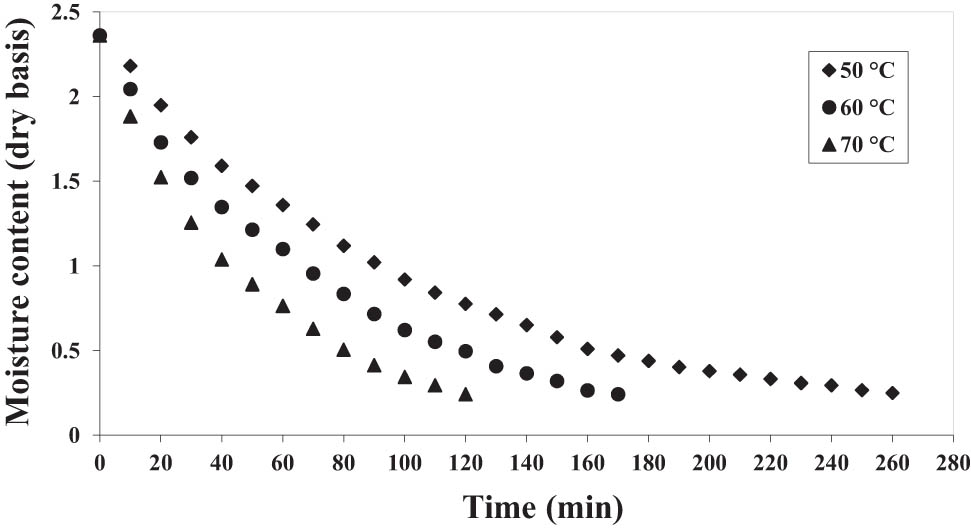
Experimental drying curves for convective drying of pomegranate arils under different air temperatures, in the form of dry basis moisture content versus drying time.
As expected, the increment in the drying air temperature caused a decrease in drying time of pomegranate, which is in line with the results of Agbede et al. (2020) and Cuccurullo et al. (2019). In the process of CV drying, increasing the drying air temperature from 50 to 70°C lead to the increase in mass transfer ratio and a reduction in the drying process time and energy consumption. Drying time for pomegranate arils were 260, 170, and 120 min at 50, 60, and 70°C, respectively. The results are in accordance with Süfer and Palazoglu (2019) that, for pomegranate arils, reported the drying times of 660, 240, and 150 min at air velocity 1 m/s for three drying air temperatures 55, 65, and 75°C, respectively. Contrarily, Briki et al. (2019) reported that air temperature had a small effect on drying time in CV drying of pomegranate arils in the temperature range similar to that of the present work, 50–70°C.
The mathematical modelling of pomegranate arils’ drying kinetics in the CV dryer was done using five common mathematical models for thin layer products (Table 1). For all CV drying experiments (50, 60, and 70°C air temperature and 1 m/s air velocity), the calculated values of regression coefficient (R
2), RMSE, and reduced
Statistical parameters characterizing the modelling of pomegranate arils’ drying in CV dryer
| Model | R 2 |
|
RMSE | ||||||
|---|---|---|---|---|---|---|---|---|---|
| 50°C | 60°C | 70°C | 50°C | 60°C | 70°C | 50°C | 60°C | 70°C | |
| Page | 0.9999 | 0.9997 | 0.9997 | 0.0002 | 0.0010 | 0.0011 | 0.0159 | 0.0175 | 0.0181 |
| Aghbashlo | 0.9996 | 0.9995 | 0.9996 | 0.0014 | 0.0017 | 0.0015 | 0.0201 | 0.0221 | 0.0207 |
| Wang and Singh | 0.9975 | 0.9968 | 0.9959 | 0.0064 | 0.0105 | 0.0177 | 0.0425 | 0.0469 | 0.0533 |
| Logarithmic | 0.9977 | 0.9965 | 0.9988 | 0.0071 | 0.0126 | 0.0055 | 0.0409 | 0.0511 | 0.0354 |
| Two-term | 0.9935 | 0.9947 | 0.9960 | 0.0339 | 0.0259 | 0.0754 | 0.0224 | 0.0611 | 0.0525 |
Figure 2 shows the variation in pomegranate arils’ MC (dry basis) with drying time in MW dryer at different MW powers (270, 450, and 630 W). It can be observed that the rate of water loss in MW method was higher than CV because of the electromagnetic heating effect of MW in drying food products. In addition, with higher MW power, more heat generated within the sample creates a larger vapour pressure difference between the centre and the product’s surface, thus accelerating the interior moisture migration and increasing surface water evaporation (Dai et al. 2019). In MW, the duration of the drying processes was 40, 80, and 140 min at 630, 450, and 270 W, respectively. As expected, the results showed that increasing MW power tends to decrease the drying time. Similar trends were obtained by other researchers for drying fruit in MW dryers, such as for quince slices (Taghinezhad et al. 2020), kiwi slices (Darvishi et al. 2016), and apple slices (Horuz et al. 2018).
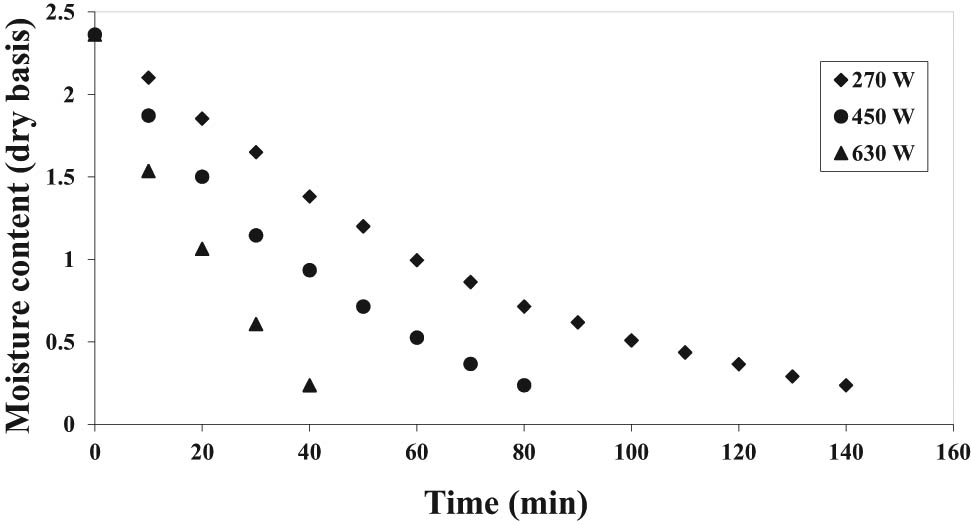
Experimental drying curves for microwave drying of pomegranate arils under different microwave powers, in the form of dry basis moisture content versus drying time.
Table 3 presents the results of the fitting with mathematical models to data of pomegranate arils drying by MW method. For all MW drying experiments, values of R
2, RMSE, and
Statistical parameters characterizing the modelling of pomegranate arils’ drying in MW dryer
| Model | R 2 |
|
RMSE | ||||||
|---|---|---|---|---|---|---|---|---|---|
| 270 W | 450 W | 630 W | 270 W | 450 W | 630 W | 270 W | 450 W | 630 W | |
| Page | 0.9999 | 0.9997 | 0.9995 | 0.0004 | 0.0009 | 0.0018 | 0.0193 | 0.0224 | 0.0241 |
| Aghbashlo | 0.9997 | 0.9992 | 0.9993 | 0.0011 | 0.0032 | 0.0027 | 0.0239 | 0.0283 | 0.0268 |
| Wang and Singh | 0.9966 | 0.9970 | 0.9949 | 0.0132 | 0.0147 | 0.0262 | 0.0488 | 0.0452 | 0.0696 |
| Logarithmic | 0.9982 | 0.9974 | 0.9967 | 0.0098 | 0.0121 | 0.0158 | 0.0349 | 0.0444 | 0.0499 |
| Two-term | 0.9929 | 0.9951 | 0.9938 | 0.0369 | 0.0229 | 0.0311 | 0.0831 | 0.0672 | 0.0761 |
Darvishi et al. (2014) dried white mulberry in MW drying at 100, 200, 300, 400, and 500 W power levels and applied to the experimental data of five thin layer models: Lewis, Henderson and Pabis, Page, Wang and Singh, and Midilli et al. Their results showed that the Page model presented the highest value of R
2 (0.999), and lower RMSE (0.009) and
Table 4 presents the values obtained for all parameters in the models listed in Table 1, obtained by fitting the experimental data for both types of drying CV and MW. These parameters allowed making predictions of the drying curves, and therefore Figure 3 shows these curves predicted with model Page together with the experimental points. The selection of the model Page to highlight this fitting was because based on the previous discussion of the results, the Page model was the one with best fitting performance for both dryings, CV and MW. The results in Figure 3 confirm the good agreement between the experimental and predicted curves for the three temperatures in the case of CV and three powers in the case of MW.
Model parameters for equations in Table 1 obtained for experimental fitting of the data for CV and MW drying of pomegranate arils
| Model parameters | Convective drying | Microwave drying | ||||
|---|---|---|---|---|---|---|
| 50°C | 60°C | 70°C | 270 W | 450 W | 630 W | |
| Page | ||||||
| k | 1.950 × 10−4 | 3.165 × 10−4 | 6.358 × 10−4 | 6.451 × 10−5 | 1.885 × 10−4 | 2.103 × 10−4 |
| n | 9.737 × 10−1 | 9.589 × 10−1 | 9.189 × 10−1 | 1.158 | 1.099 | 1.176 |
| Aghbashlo | ||||||
| a | 1.607 × 10−4 | 2.304 × 10−4 | 3.608 × 10−4 | 2.039 × 10−4 | 3.567 × 10−4 | 5.893 × 10−4 |
| b | 4.999 × 10−6 | 5.886 × 10−6 | 2.530 × 10−5 | −3.249 × 10−5 | −4.470 × 10−5 | −1.391 × 10−4 |
| Wang and Singh | ||||||
| a | −1.281 × 10−4 | −1.843 × 10−4 | −2.718 × 10−4 | −1.950 × 10−4 | −3.285 × 10−4 | −5.728 × 10−4 |
| b | 4.709 × 10−9 | 9.776 × 10−9 | 2.121 × 10−8 | 1.060 × 10−8 | 3.010 × 10−8 | 8.418 × 10−8 |
| Logarithmic | ||||||
| a | 9.770 × 10−1 | 9.856 × 10−1 | 9.531 × 10−1 | 1.138 | 1.135 | 1.331 |
| k | 1.646 × 10−4 | 2.171 × 10−4 | 3.485 × 10−4 | 1.991 × 10−4 | 3.204 × 10−4 | 4.540 × 10−4 |
| c | 2.681 × 10−2 | −3.530 × 10−3 | 3.248 × 10−2 | −1.221 × 10−1 | −1.390 × 10−1 | −3.387 × 10−1 |
| Two-term | ||||||
| a | 9.770 × 10−1 | 3.918 × 10−2 | 8.455 × 10−2 | 5.203 × 10−1 | 5.003 × 10−1 | 5.037 × 10−1 |
| k 0 | 1.646 × 10−4 | 2.296 × 10−3 | 1.819 × 10−3 | 2.519 × 10−4 | 4.154 × 10−4 | 7.615 × 10−4 |
| b | 2.681 × 10−2 | 9.621 × 10−1 | 9.162 × 10−1 | 5.181 × 10−1 | 5.147 × 10−1 | 5.092 × 10−1 |
| K 1 | 3.270 × 10−14 | 2.140 × 10−4 | 3.009 × 10−4 | 2.519 × 10−4 | 4.155 × 10−4 | 7.615 × 10−4 |
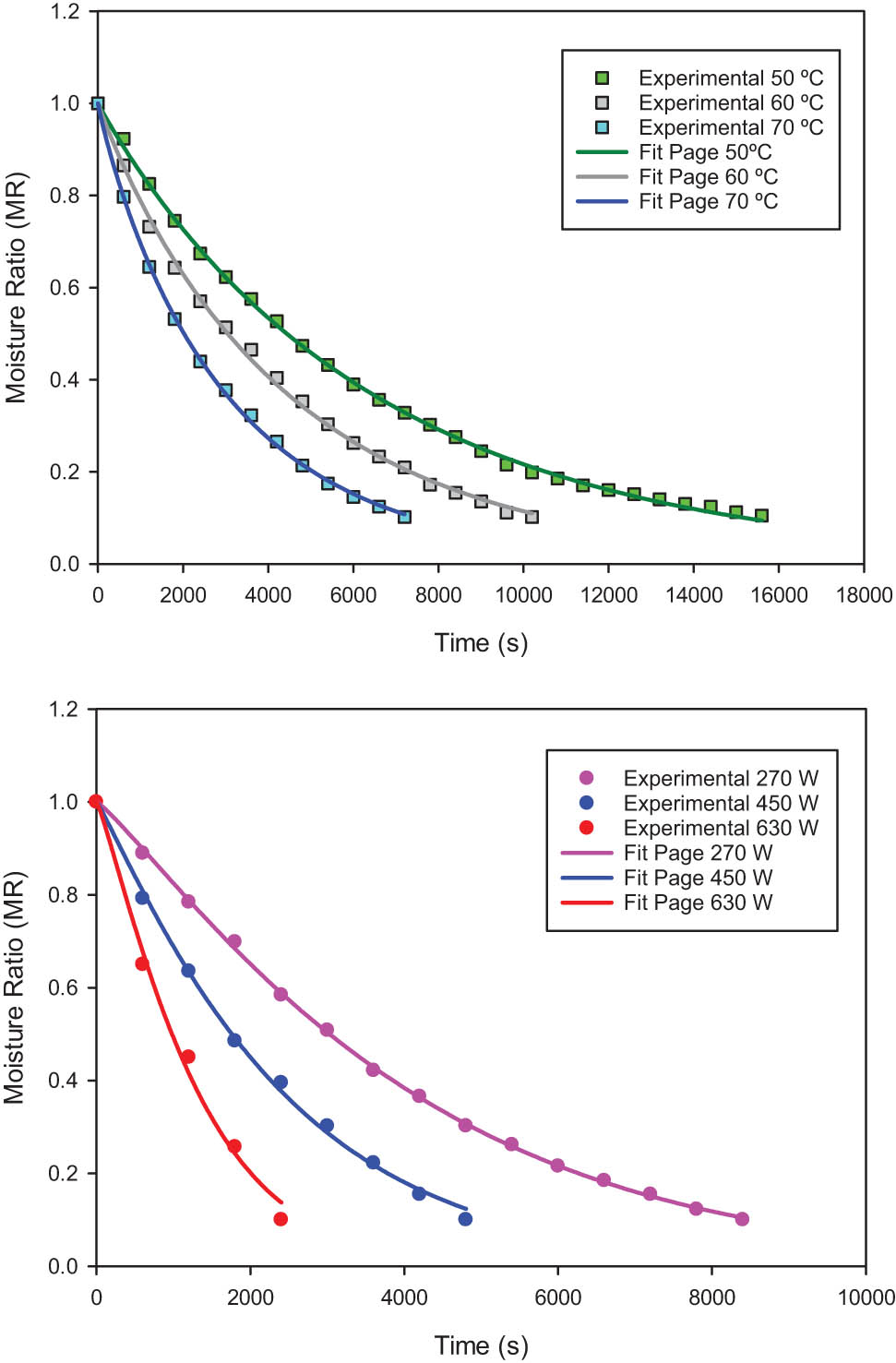
Experimental curves for moisture ratio versus time and fitting with model Page for convective drying (top) and for microwave drying (bottom) of pomegranate arils.
3.2 Effective moisture diffusivity
The D
eff values of pomegranate arils at different drying temperatures were calculated by equation (10). Taghinezhad et al. (2020) reported that, for agricultural and food products,
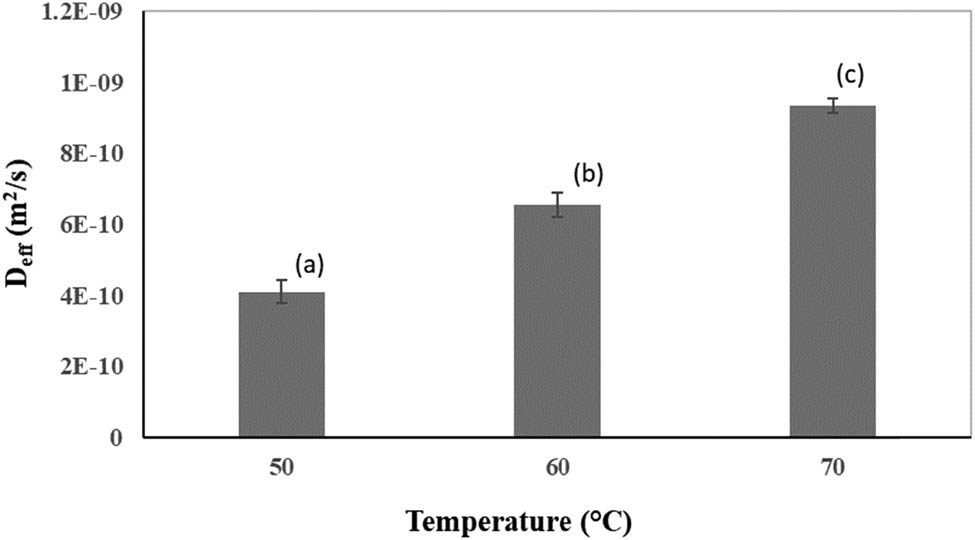
Variation in
The values of
The values of
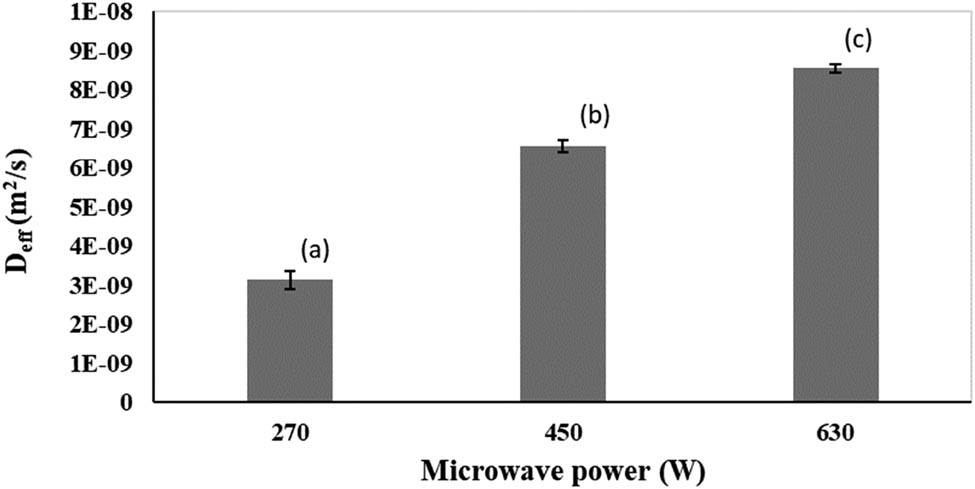
Variation in
The MWs accelerate the vibration of water molecules present in the pomegranate arils, and their faster evaporation, thus providing a faster decrease in the pomegranate arils’ MC and the corresponding higher value of
3.3 Activation energy
During drying, the highest values of activation energy (E a) obtained for CV and MW methods were 63.11 kJ/mol and 14.13 W/g, respectively (Table 5). The air temperature and MW power were important factors influencing the D eff and also the activation energy. It is confirmed that increasing the temperature and MW power reduces the E a, as a result of higher mass transfer and moisture loss of pomegranate arils.
Estimated activation energy in CV and MW dryers
| Convective dryer | Microwave dryer | ||
|---|---|---|---|
| Air temperature (°C) | E a (kJ/mol) | Microwave power (W) | E a (W/g) |
| 50 | 63.11 | 270 | 14.13 |
| 60 | 52.52 | 450 | 13.50 |
| 70 | 37.28 | 630 | 13.09 |
The obtained results are in line with those reported by Jebri et al. (2019), according to which the values of E a for CV and MW drying of Salvia officinalis leaves were 1.054 kJ/mol and 4.85 W/g, respectively. İlter et al. (2018), in their study about drying of garlic puree, obtained E a values of 20.90 kJ/mol and 21.96 W/g, in CV and in MW dryers, respectively.
3.4 Specific energy consumption
Figure 6 shows the values of SEC for three drying temperatures of pomegranate aril in CV dryer. In this study, the SEC obtained was in the range of 79.44–145.12 kWh/kg. The highest and lowest SEC values were consumed at drying temperatures of 50 and 70°C, respectively. From Figure 6, it is also observed that SEC reduces with the increase in the drying air temperature.
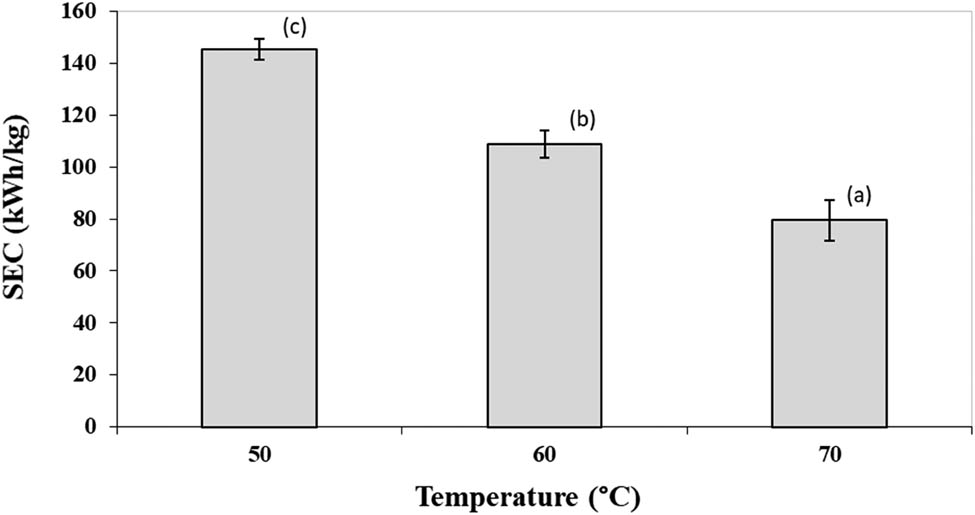
Values of SEC in CV for different drying air temperatures. The bars represent mean values and the corresponding standard deviations. Bars with the same letter are not significantly different according to ANOVA and Tukey test (p < 0.05).
Even though the specific heat of the air is lower at higher temperatures, the increase in the air temperature of the drying chamber decreases the amount of energy consumed by the process because of the substantial reduction in the process duration at these temperatures (Kaveh et al. 2020). The values of SEC are considerably higher than the reported value of 21.57 kWh/kg for CV drying of dog-rose at 40°C and 1 m/s (Motevali and Koloor 2017), but lower that 184.29 kWh/kg reported for the drying of Pistacia atlantica in CV dryer with hot air at 40°C and an air velocity of 1.5 m/s (Kaveh et al. 2020).
As shown in Figure 7, during the drying process of pomegranate arils in MW dryer, the SEC at 270 and 630 W were obtained as 35.42 and 13.19 (kWh/kg), respectively. In this case, the ratio between the highest and lowest values of SEC is 2.68. According to the results, with the increase in MW power, a significant decrease in SEC is observed, almost three times less.
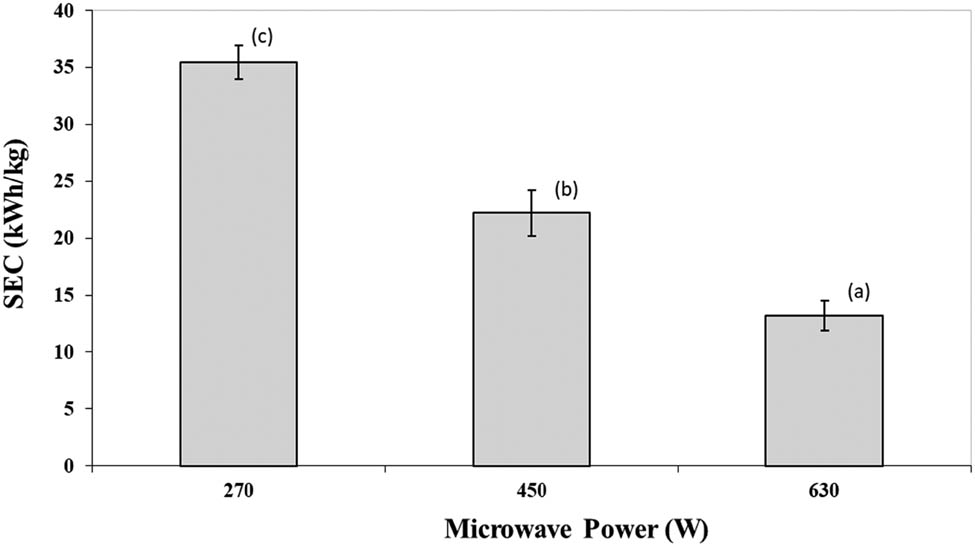
Values of SEC in MW for different microwave powers. The bars represent mean values and the corresponding standard deviations. Bars with the same letter are not significantly different according to ANOVA and Tukey test (p < 0.05).
The reduction in SEC at higher MW power is because of the effect of its volumetric heating, which reduces the drying time (Taghinezhad et al. 2020). Advantages such as shorter drying times and lower SEC were the key drivers for the further development of the MW drying technique (Motevali and Koloor 2017). In the drying of cherry tomatoes, Kipcak and Doymaz (2020) reported that the minimum obtained value of SEC was 0.0420 kWh at MW power 360 W. In addition, Çelen (2019), in MW drying of trabzon persimmon, report that the maximum and minimum values of SEC obtained were 0.05 and 0.1 kWh, at the range of MW power 120–600 W. Although these values are not directly comparable with ours, they also allow calculating the ration between highest and lowest values of SEC, which is for the MW drying of trabzon persimmon equal to 2, which is relatively similar to the value we obtained of 2.68.
3.5 Colour
Colour is one of the most important marketing qualitative properties of fresh or processed food products. Figure 8 shows the colour variations (
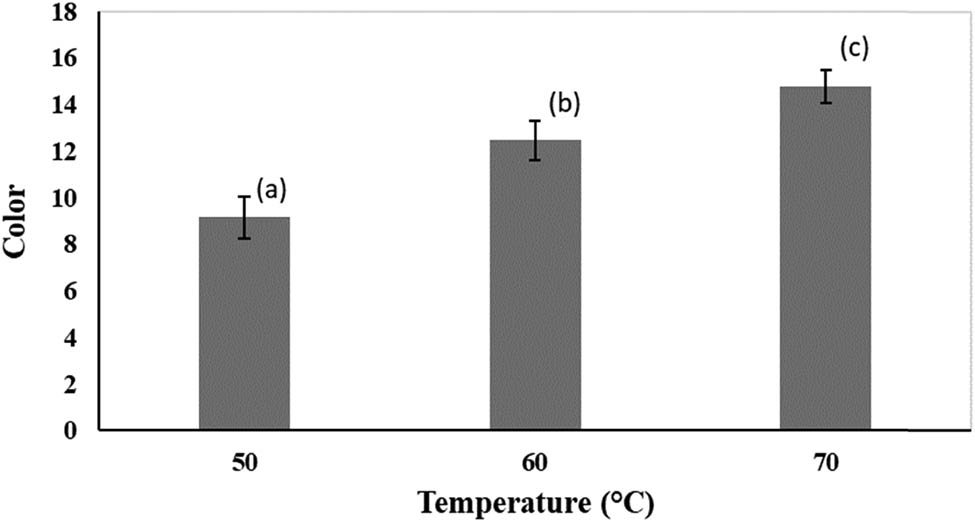
Colour change of dried pomegranate arils in CV dryer. The bars represent mean values and the corresponding standard deviations. Bars with the same letter are not significantly different according to ANOVA and Tukey test (p < 0.05).
As shown in Figure 9, colour changes in MW dryer increased from 6.77 to 13.11 with the increase in MW power from 270 to 630 W. In the MW drying process, the MW power and process duration are the relevant factors that influence the sample colour change. The change in the colour of the pigments can be because of the effect of heat on heat-sensitive compounds such as carbohydrates, proteins, and vitamins, which also causes colour change during the drying process (Xu et al. 2020). According to Horuz and Maskan (2015), the maximum and minimum values of 3.87 and 27.93 were obtained for colour change of pomegranate arils in MW drying for powers varying in the range of 210‒490 W.
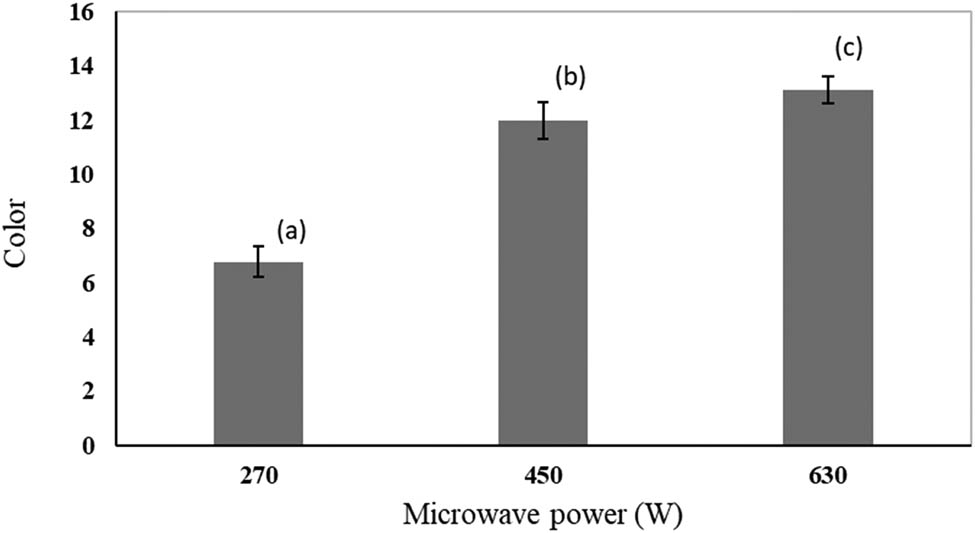
Colour change of dried pomegranate arils in MW dryer. The bars represent mean values and the corresponding standard deviations. Bars with the same letter are not significantly different according to ANOVA and Tukey test (p < 0.05).
3.6 Shrinkage
The values of pomegranate arils shrinkage for CV and MW dryers are reported in Figures 10 and 11, respectively. As can be observed in Figure 10, from the experiments in CV dryer, the shrinkage ranged from 54.35 to 76.8%, for the drying temperatures of 70 and 50°C respectively.
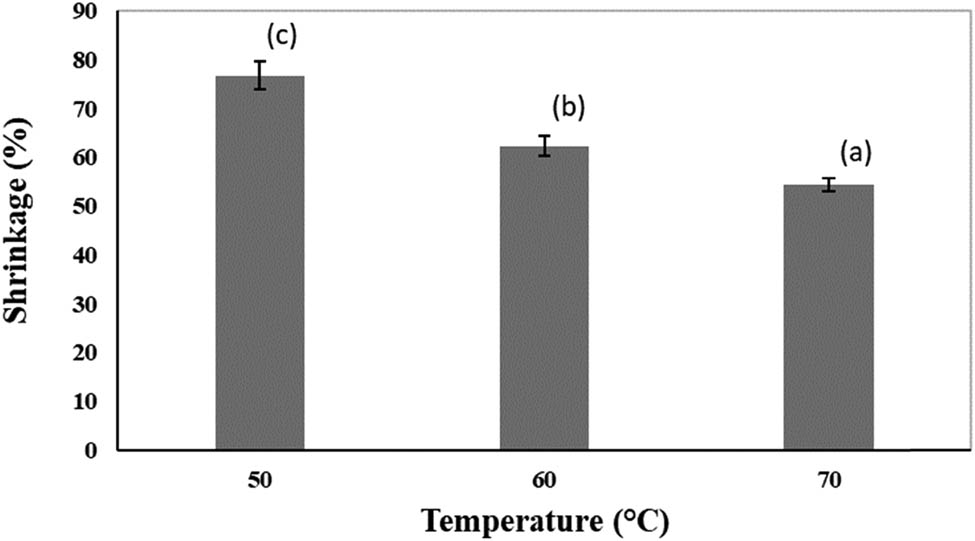
Shrinkage of dried pomegranate arils in CV dryer. The bars represent mean values and the corresponding standard deviations. Bars with the same letter are not significantly different according to ANOVA and Tukey test (p < 0.05).
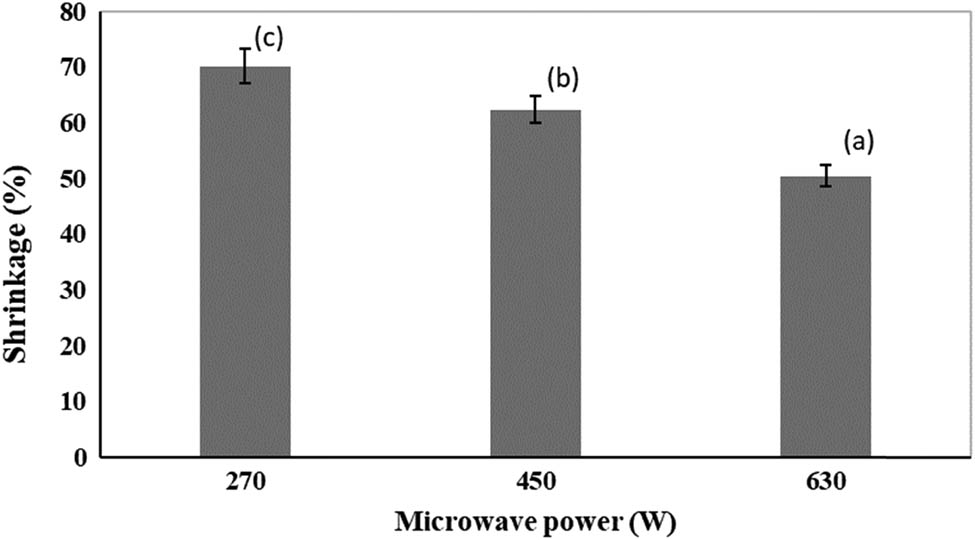
Shrinkage of dried pomegranate arils in MW dryer. The bars represent mean values and the corresponding standard deviations. Bars with the same letter are not significantly different according to ANOVA and Tukey test (p < 0.05).
In the MW drying approach, as shown in Figure 11, the highest shrinkage (70.21%) was obtained at the MW power of 270 W, and the lowest value (50.5%) occurred for MW power of 630 W.
The results obtained from both drying techniques indicate that increasing the drying air temperature or MW power led to faster processes and consequently to lower shrinkage rates. This may be explained by the shrinkage rate dependence from sample MC, so increasing drying air temperature or MW power causes higher rate of water evaporation. Yemmireddy et al. (2013) reported that drying at lower temperatures promoted relatively more shrinkage as compared with higher temperatures, which was explained by the fact that at longer drying times the samples have more time to allow the structure rearrangements and shrinking. During the drying process, the intercellular water moves regularly and air replaces it, and this leads to tensions in the structure of the cells. As a result, the texture would not be able to keep its structural network, the external structure of the cell collapses, and shrinkage takes place (Ashtiani et al. 2018). These changes were more evident for the samples submitted to CV drying as compared with MW drying.
Our results are in accordance with those reported by Horuz and Maskan (2015) in their work on drying pomegranates, according to which the maximum shrinkage rates were 78.57% for a drying temperature of 50°C (in a tested range from 50 to 70°C) and 65.45% for a MW power of 210 W (in a tested range from 270 to 630 W). However, contradicting results were obtained by Süfer and Palazoglu, (2019) in their study on CV drying of pomegranate arils, according to which the highest shrinkage rate (79.74%) was achieved for a higher drying temperature (75°C), and the lowest (72.88%) for a temperature of 55°C.
4 Conclusions
In this study, the effects of CV drying at three air temperatures (50, 60, and 70°C) and MW drying at three MW powers (270, 450, and 630 W) on the drying characteristics of pomegranate arils were evaluated. The duration of the process for pomegranate arils’ drying by MW was shorter if compared to CV drying. The results showed that the Page model was the most suitable for prediction of pomegranate arils’ MR. This model presented the highest coefficients of determination (R
2) and the lowest
Acknowledgments
This work was funded by National Funds through the FCT – Foundation for Science and Technology, I.P., within the scope of the project Refa UIDB/00681/2020. Furthermore, the authors would like to thank the CERNAS Research Centre and the Polytechnic Institute of Viseu for their support.
-
Funding information: The open access article processing charges were funded by FCT – Foundation for Science and Technology, I.P., through CERNAS Research Centre, within the scope of the project Refa UIDB/00681/2020.
-
Author contribution: MK and IG: conceptualization; MK, IG, and RG: data curation; MK, IG, and SG: formal analysis; RG and JCG: funding acquisition; MK and IG: methodology; MK and IG: resources; MK, IG, and SG: writing – original draft; RG and JCG: writing – review and editing.
-
Conflict of interest: The authors state no conflict of interest.
-
Data availability statement: The datasets generated during and/or analysed during the current study are available from the corresponding author on reasonable request.
References
[1] Agbede OO, Oke EO, Akinfenwa SI, Wahab KT, Ogundipe S, Aworanti OA, et al. Thin layer drying of green microalgae (Chlorella sp.) paste biomass: drying characteristics, energy requirement and mathematical modeling. Bioresour Technol Rep. 2020;11:1–12. 10.1016/j.biteb.2020.100467.Suche in Google Scholar
[2] Alaei B, Chayjan RA. Drying characteristics of pomegranate arils under near infrared-vacuum conditions. J Food Process Preserv. 2015;39:469–79. 10.1111/jfpp.12252.Suche in Google Scholar
[3] Ashtiani S-HM, Sturm B, Nasirahmadi A. Effects of hot-air and hybrid hot air-microwave drying on drying kinetics and textural quality of nectarine slices. Heat Mass Transf. 2018;54:915–27. 10.1007/s00231-017-2187-0.Suche in Google Scholar
[4] Briki S, Zitouni B, Bechaa B, Amiali M. Comparison of convective and infrared heating as means of drying pomegranate arils (Punica granatum L.). Heat Mass Transf. 2019;55:3189–99. 10.1007/s00231-019-02644-8.Suche in Google Scholar
[5] Castro AM, Mayorga EY, Moreno FL. Mathematical modelling of convective drying of fruits: a review. J Food Eng. 2018;223:152–67. 10.1016/j.jfoodeng.2017.12.012.Suche in Google Scholar
[6] Çelen S. Effect of microwave drying on the drying characteristics, color, microstructure, and thermal properties of Trabzon Persimmon. Foods. 2019;84:1–19. 10.3390/foods8020084.Suche in Google Scholar PubMed PubMed Central
[7] Cuccurullo G, Metallo A, Corona O, Cinquanta L. Comparing different processing methods in apple slice drying. Part 1. Performance of microwave, hot air and hybrid methods at constant temperatures. Biosyst Eng. 2019;188:331–44. 10.1016/j.biosystemseng.2019.10.021.Suche in Google Scholar
[8] Dai J-W, Xiao H-W, Zhang L-H, Chu M-Y, Qin W, Wu Z-J, et al. Drying characteristics and modeling of apple slices during microwave intermittent drying. J Food Process Eng. 2019;42:e13212. 10.1111/jfpe.13212.Suche in Google Scholar
[9] Darvishi H, Zarein M, Farhudi Z. Energetic and exergetic performance analysis and modeling of drying kinetics of kiwi slices. J Food Sci Technol. 2016;53:2317–33. 10.1007/s13197-016-2199-7.Suche in Google Scholar PubMed PubMed Central
[10] Darvishi H, Zarein M, Minaei S, Khafajeh H. Exergy and energy analysis, drying kinetics and mathematical modeling of white mulberry drying process. Int J Food Eng. 2014;10:269–80. 10.1515/ijfe-2013-0065.Suche in Google Scholar
[11] Dehghannya J, Kadkhodaei S, Heshmati MK, Ghanbarzadeh B. Ultrasound-assisted intensification of a hybrid intermittent microwave - hot air drying process of potato: quality aspects and energy consumption. Ultrasonics. 2019;96:104–22. 10.1016/j.ultras.2019.02.005.Suche in Google Scholar PubMed
[12] Galaz P, Valdenegro M, Ramírez C, Nuñez H, Almonacid S, Simpson R. Effect of drum drying temperature on drying kinetic and polyphenol contents in pomegranate peel. J Food Eng. 2017;208:19–27. 10.1016/j.jfoodeng.2017.04.002.Suche in Google Scholar
[13] Horuz E, Bozkurt H, Karataş H, Maskan M. Simultaneous application of microwave energy and hot air to whole drying process of apple slices: drying kinetics, modeling, temperature profile and energy aspect. Heat Mass Transf. 2018;54:425–36. 10.1007/s00231-017-2152-y.Suche in Google Scholar
[14] Horuz E, Maskan M. Hot air and microwave drying of pomegranate (Punica granatum L.) arils. J Food Sci Technol. 2015;52:285–93. 10.1007/s13197-013-1032-9.Suche in Google Scholar
[15] İlter I, Akyıl S, Devseren E, Okut D, Koç M, Kaymak Ertekin F. Microwave and hot air drying of garlic puree: drying kinetics and quality characteristics. Heat Mass Transf. 2018;54:2101–12. 10.1007/s00231-018-2294-6.Suche in Google Scholar
[16] Jebri M, Desmorieux H, Maaloul A, Saadaoui E, Romdhane M. Drying of Salvia officinalis L. by hot air and microwaves: dynamic desorption isotherms, drying kinetics and biochemical quality. Heat Mass Transf. 2019;55:1143–53. 10.1007/s00231-018-2498-9.Suche in Google Scholar
[17] Kaderides K, Papaoikonomou L, Serafim M, Goula AM. Microwave-assisted extraction of phenolics from pomegranate peels: Optimization, kinetics, and comparison with ultrasounds extraction. Chem Eng Process Process Intensif. 2019;137:1–11. 10.1016/j.cep.2019.01.006.Suche in Google Scholar
[18] Kaveh M, Amiri Chayjan R, Taghinezhad E, Rasooli Sharabiani V, Motevali A. Evaluation of specific energy consumption and GHG emissions for different drying methods (Case study: Pistacia Atlantica). J Clean Prod. 2020;259:120963. 10.1016/j.jclepro.2020.120963.Suche in Google Scholar
[19] Kayran S, Doymaz İ. Determination of drying kinetics and physicochemical characterization of apricot pomace in hot-air dryer. J Therm Anal Calorim. 2017;130:1163–70. 10.1007/s10973-017-6504-0.Suche in Google Scholar
[20] Kingsly ARP, Singh DB. Drying kinetics of pomegranate arils. J Food Eng. 2007;79:741–4. 10.1016/j.jfoodeng.2006.02.033.Suche in Google Scholar
[21] Kipcak AS, Doymaz İ. Microwave and infrared drying kinetics and energy consumption of cherry tomatoes. Chem Ind Chem Eng Q. 2020;26:203–12.10.2298/CICEQ190916039KSuche in Google Scholar
[22] Kumar S, Grekov D, Pré P, Alappat BJ. Microwave mode of heating in the preparation of porous carbon materials for adsorption and energy storage applications – an overview. Renew Sustain Energy Rev. 2020;124:109743. 10.1016/j.rser.2020.109743.Suche in Google Scholar
[23] Minaei S, Motevali A, Najafi G, Seyedi SRM. Influence of drying methods on activation energy, effective moisture diffusion and drying rate of pomegranate arils (Punica granatum). Aust J Crop Sci. 2012;6:584–91.Suche in Google Scholar
[24] Motevali A, Koloor RT. A comparison between pollutants and greenhouse gas emissions from operation of different dryers based on energy consumption of power plants. J Clean Prod. 2017;154:445–61. 10.1016/j.jclepro.2017.03.219.Suche in Google Scholar
[25] Mphahlele RR, Pathare PB, Opara UL. Drying kinetics of pomegranate fruit peel (cv. Wonderful). Sci Afr. 2019;5:e00145. 10.1016/j.sciaf.2019.e00145.Suche in Google Scholar
[26] Orsat V, Changrue V, Raghavan GV. Microwave drying of fruits and vegetables. Stewart Postharvest Rev. 2006;6:1–7.10.2212/spr.2006.6.4Suche in Google Scholar
[27] Rattanadecho P, Makul N. Microwave-assisted drying: a review of the state-of-the-art. Dry Technol. 2016;34:1–38. 10.1080/07373937.2014.957764.Suche in Google Scholar
[28] Sakare P, Prasad N, Thombare N, Singh R, Sharma SC. Infrared drying of food materials: recent advances. Food Eng Rev. 2020;12:381–98. 10.1007/s12393-020-09237-w.Suche in Google Scholar
[29] Süfer Ö, Palazoğlu TK. A study on hot-air drying of pomegranate. J Therm Anal Calorim. 2019;137:1981–90. 10.1007/s10973-019-08102-1.Suche in Google Scholar
[30] Taghinezhad E, Kaveh M, Jahanbakhshi A, Golpour I. Use of artificial intelligence for the estimation of effective moisture diffusivity, specific energy consumption, color and shrinkage in quince drying. J Food Process Eng. 2020;43:e13358. 10.1111/jfpe.13358.Suche in Google Scholar
[31] Xu Y, Xiao Y, Lagnika C, Li D, Liu C, Jiang N, et al. A comparative evaluation of nutritional properties, antioxidant capacity and physical characteristics of cabbage (Brassica oleracea var. Capitate var L.) subjected to different drying methods. Food Chem. 2020;309:e124935. 10.1016/j.foodchem.2019.06.002.Suche in Google Scholar PubMed
[32] Yemmireddy VK, Chinnan MS, Kerr WL, Hung Y-C. Effect of drying method on drying time and physico-chemical properties of dried rabbiteye blueberries. LWT Food Sci Technol. 2013;50:739–45. 10.1016/j.lwt.2012.07.011.Suche in Google Scholar
© 2021 Mohammad Kaveh et al., published by De Gruyter
This work is licensed under the Creative Commons Attribution 4.0 International License.
Artikel in diesem Heft
- Regular Articles
- The nutmeg seedlings growth under pot culture with biofertilizers inoculation
- Recovery of heather (Calluna vulgaris) flowering in northern Finland
- Soil microbiome of different-aged stages of self-restoration of ecosystems on the mining heaps of limestone quarry (Elizavetino, Leningrad region)
- Conversion of land use and household livelihoods in Vietnam: A study in Nghe An
- Foliar selenium application for improving drought tolerance of sesame (Sesamum indicum L.)
- Assessment of deficit irrigation efficiency. Case study: Middle Sebou and Innaouene downstream
- Integrated weed management practices and sustainable food production among farmers in Kwara State, Nigeria
- Determination of morphological changes using gamma irradiation technology on capsicum specie varieties
- Use of maturity traits to identify optimal harvestable maturity of banana Musa AAB cv. “Embul” in dry zone of Sri Lanka
- Theory vs practice: Patterns of the ASEAN-10 agri-food trade
- Intake, nutrient digestibility, nitrogen, and mineral balance of water-restricted Xhosa goats supplemented with vitamin C
- Physicochemical properties of South African prickly pear fruit and peel: Extraction and characterisation of pectin from the peel
- An evaluation of permanent crops: Evidence from the “Plant the Future” project, Georgia
- Probing of the genetic components of seedling emergence traits as selection indices, and correlation with grain yield characteristics of some tropical maize varieties
- Increase in the antioxidant content in biscuits by infusions or Prosopis chilensis pod flour
- Altitude, shading, and management intensity effect on Arabica coffee yields in Aceh, Indonesia
- Climate change adaptation and cocoa farm rehabilitation behaviour in Ahafo Ano North District of Ashanti region, Ghana
- Effect of light spectrum on growth, development, and mineral contents of okra (Abelmoschus esculentus L.)
- An assessment of broiler value chain in Nigeria
- Storage root yield and sweetness level selection for new honey sweet potato (Ipomoea batatas [L.] Lam)
- Direct financial cost of weed control in smallholder rubber plantations
- Combined application of poultry litter biochar and NPK fertilizer improves cabbage yield and soil chemical properties
- How does willingness and ability to pay of palm oil smallholders affect their willingness to participate in Indonesian sustainable palm oil certification? Empirical evidence from North Sumatra
- Investigation of the adhesion performance of some fast-growing wood species based on their wettability
- The choice of information sources and marketing channel of Bali cattle farmers in Bali Province
- Preliminary phytochemical screening and in vitro antibacterial activity of Plumbago indica (Laal chitrak) root extracts against drug-resistant Escherichia coli and Klebsiella pneumoniae
- Agronomic and economic performance of maize (Zea mays L.) as influenced by seed bed configuration and weed control treatments
- Selection and characterization of siderophores of pathogenic Escherichia coli intestinal and extraintestinal isolates
- Effectiveness of cowpea (Vigna unguiculata L.) living mulch on weed suppression and yield of maize (Zea mays L.)
- Cow milk and its dairy products ameliorate bone toxicity in the Coragen-induced rat model
- The motives of South African farmers for offering agri-tourism
- Morphophysiological changes and reactive oxygen species metabolism in Corchorus olitorius L. under different abiotic stresses
- Nanocomposite coatings for hatching eggs and table eggs
- Climate change stressors affecting household food security among Kimandi-Wanyaga smallholder farmers in Murang’a County, Kenya
- Genetic diversity of Omani barley (Hordeum vulgare L.) germplasm
- Productivity and profitability of organic and conventional potato (Solanum tuberosum L.) production in West-Central Bhutan
- Response of watermelon growth, yield, and quality to plant density and variety in Northwest Ethiopia
- Sex allocation and field population sex ratio of Apanteles taragamae Viereck (Hymenoptera: Braconidae), a larval parasitoid of the cucumber moth Diaphania indica Saunders (Lepidoptera: Crambidae)
- Comparison of total nutrient recovery in aquaponics and conventional aquaculture systems
- Relationships between soil salinity and economic dynamics: Main highlights from literature
- Effects of soil amendments on selected soil chemical properties and productivity of tef (Eragrostis tef [Zucc.] Trotter) in the highlands of northwest Ethiopia
- Influence of integrated soil fertilization on the productivity and economic return of garlic (Allium sativum L.) and soil fertility in northwest Ethiopian highlands
- Physiological and biochemical responses of onion plants to deficit irrigation and humic acid application
- The incorporation of Moringa oleifera leaves powder in mutton patties: Influence on nutritional value, technological quality, and sensory acceptability
- Response of biomass, grain production, and sugar content of four sorghum plant varieties (Sorghum bicolor (L.) Moench) to different plant densities
- Assessment of potentials of Moringa oleifera seed oil in enhancing the frying quality of soybean oil
- Influences of spacing on yield and root size of carrot (Daucus carota L.) under ridge-furrow production
- Review Articles
- A review of upgradation of energy-efficient sustainable commercial greenhouses in Middle East climatic conditions
- Plantago lanceolata – An overview of its agronomically and healing valuable features
- Special Issue on CERNAS 2020
- The role of edible insects to mitigate challenges for sustainability
- Morphology and structure of acorn starches isolated by enzymatic and alkaline methods
- Evaluation of FT-Raman and FTIR-ATR spectroscopy for the quality evaluation of Lavandula spp. Honey
- Factors affecting eating habits and knowledge of edible flowers in different countries
- Ideal pH for the adsorption of metal ions Cr6+, Ni2+, Pb2+ in aqueous solution with different adsorbent materials
- Determination of drying kinetics, specific energy consumption, shrinkage, and colour properties of pomegranate arils submitted to microwave and convective drying
- Eating habits and food literacy: Study involving a sample of Portuguese adolescents
- Characterization of dairy sheep farms in the Serra da Estrela PDO region
- Development and characterization of healthy gummy jellies containing natural fruits
- Agro-ecological services delivered by legume cover crops grown in succession with grain corn crops in the Mediterranean region
- Special issue on CERNAS 2020: Message from the Editor
- Special Issue on ICESAT 2019
- Climate field schools to increase farmers’ adaptive capacity to climate change in the southern coastline of Java
- Special Issue on the International Conference on Agribusiness and Rural Development - IConARD 2020
- Supply chain efficiency of red chili based on the performance measurement system in Yogyakarta, Indonesia
- Sustainable value of rice farm based on economic efficiency in Yogyakarta, Indonesia
- Enhancing the performance of conventional coffee beans drying with low-temperature geothermal energy by applying HPHE: An experimental study
- Opportunities of using Spirulina platensis as homemade natural dyes for textiles
- Special Issue on the APA 2019 - 11th Triennial Conference
- Expanding industrial uses of sweetpotato for food security and poverty alleviation
- A survey on potato productivity, cultivation and management constraints in Mbala district of Northern Zambia
- Orange-fleshed sweetpotato: Strategies and lessons learned for achieving food security and health at scale in Sub-Saharan Africa
- Growth and yield of potato (Solanum tuberosum L.) as affected by storage conditions and storage duration in Jos, Plateau State, Nigeria
- Special Issue on the International Conference on Multidisciplinary Research - Agrarian Sciences
- Application of nanotechnologies along the food supply chain
- Special Issue on Agriculture, Climate Change, Information Technology, Food and Animal (ACIFAS 2020)
- The use of endophytic growth-promoting bacteria to alleviate salinity impact and enhance the chlorophyll, N uptake, and growth of rice seedling
Artikel in diesem Heft
- Regular Articles
- The nutmeg seedlings growth under pot culture with biofertilizers inoculation
- Recovery of heather (Calluna vulgaris) flowering in northern Finland
- Soil microbiome of different-aged stages of self-restoration of ecosystems on the mining heaps of limestone quarry (Elizavetino, Leningrad region)
- Conversion of land use and household livelihoods in Vietnam: A study in Nghe An
- Foliar selenium application for improving drought tolerance of sesame (Sesamum indicum L.)
- Assessment of deficit irrigation efficiency. Case study: Middle Sebou and Innaouene downstream
- Integrated weed management practices and sustainable food production among farmers in Kwara State, Nigeria
- Determination of morphological changes using gamma irradiation technology on capsicum specie varieties
- Use of maturity traits to identify optimal harvestable maturity of banana Musa AAB cv. “Embul” in dry zone of Sri Lanka
- Theory vs practice: Patterns of the ASEAN-10 agri-food trade
- Intake, nutrient digestibility, nitrogen, and mineral balance of water-restricted Xhosa goats supplemented with vitamin C
- Physicochemical properties of South African prickly pear fruit and peel: Extraction and characterisation of pectin from the peel
- An evaluation of permanent crops: Evidence from the “Plant the Future” project, Georgia
- Probing of the genetic components of seedling emergence traits as selection indices, and correlation with grain yield characteristics of some tropical maize varieties
- Increase in the antioxidant content in biscuits by infusions or Prosopis chilensis pod flour
- Altitude, shading, and management intensity effect on Arabica coffee yields in Aceh, Indonesia
- Climate change adaptation and cocoa farm rehabilitation behaviour in Ahafo Ano North District of Ashanti region, Ghana
- Effect of light spectrum on growth, development, and mineral contents of okra (Abelmoschus esculentus L.)
- An assessment of broiler value chain in Nigeria
- Storage root yield and sweetness level selection for new honey sweet potato (Ipomoea batatas [L.] Lam)
- Direct financial cost of weed control in smallholder rubber plantations
- Combined application of poultry litter biochar and NPK fertilizer improves cabbage yield and soil chemical properties
- How does willingness and ability to pay of palm oil smallholders affect their willingness to participate in Indonesian sustainable palm oil certification? Empirical evidence from North Sumatra
- Investigation of the adhesion performance of some fast-growing wood species based on their wettability
- The choice of information sources and marketing channel of Bali cattle farmers in Bali Province
- Preliminary phytochemical screening and in vitro antibacterial activity of Plumbago indica (Laal chitrak) root extracts against drug-resistant Escherichia coli and Klebsiella pneumoniae
- Agronomic and economic performance of maize (Zea mays L.) as influenced by seed bed configuration and weed control treatments
- Selection and characterization of siderophores of pathogenic Escherichia coli intestinal and extraintestinal isolates
- Effectiveness of cowpea (Vigna unguiculata L.) living mulch on weed suppression and yield of maize (Zea mays L.)
- Cow milk and its dairy products ameliorate bone toxicity in the Coragen-induced rat model
- The motives of South African farmers for offering agri-tourism
- Morphophysiological changes and reactive oxygen species metabolism in Corchorus olitorius L. under different abiotic stresses
- Nanocomposite coatings for hatching eggs and table eggs
- Climate change stressors affecting household food security among Kimandi-Wanyaga smallholder farmers in Murang’a County, Kenya
- Genetic diversity of Omani barley (Hordeum vulgare L.) germplasm
- Productivity and profitability of organic and conventional potato (Solanum tuberosum L.) production in West-Central Bhutan
- Response of watermelon growth, yield, and quality to plant density and variety in Northwest Ethiopia
- Sex allocation and field population sex ratio of Apanteles taragamae Viereck (Hymenoptera: Braconidae), a larval parasitoid of the cucumber moth Diaphania indica Saunders (Lepidoptera: Crambidae)
- Comparison of total nutrient recovery in aquaponics and conventional aquaculture systems
- Relationships between soil salinity and economic dynamics: Main highlights from literature
- Effects of soil amendments on selected soil chemical properties and productivity of tef (Eragrostis tef [Zucc.] Trotter) in the highlands of northwest Ethiopia
- Influence of integrated soil fertilization on the productivity and economic return of garlic (Allium sativum L.) and soil fertility in northwest Ethiopian highlands
- Physiological and biochemical responses of onion plants to deficit irrigation and humic acid application
- The incorporation of Moringa oleifera leaves powder in mutton patties: Influence on nutritional value, technological quality, and sensory acceptability
- Response of biomass, grain production, and sugar content of four sorghum plant varieties (Sorghum bicolor (L.) Moench) to different plant densities
- Assessment of potentials of Moringa oleifera seed oil in enhancing the frying quality of soybean oil
- Influences of spacing on yield and root size of carrot (Daucus carota L.) under ridge-furrow production
- Review Articles
- A review of upgradation of energy-efficient sustainable commercial greenhouses in Middle East climatic conditions
- Plantago lanceolata – An overview of its agronomically and healing valuable features
- Special Issue on CERNAS 2020
- The role of edible insects to mitigate challenges for sustainability
- Morphology and structure of acorn starches isolated by enzymatic and alkaline methods
- Evaluation of FT-Raman and FTIR-ATR spectroscopy for the quality evaluation of Lavandula spp. Honey
- Factors affecting eating habits and knowledge of edible flowers in different countries
- Ideal pH for the adsorption of metal ions Cr6+, Ni2+, Pb2+ in aqueous solution with different adsorbent materials
- Determination of drying kinetics, specific energy consumption, shrinkage, and colour properties of pomegranate arils submitted to microwave and convective drying
- Eating habits and food literacy: Study involving a sample of Portuguese adolescents
- Characterization of dairy sheep farms in the Serra da Estrela PDO region
- Development and characterization of healthy gummy jellies containing natural fruits
- Agro-ecological services delivered by legume cover crops grown in succession with grain corn crops in the Mediterranean region
- Special issue on CERNAS 2020: Message from the Editor
- Special Issue on ICESAT 2019
- Climate field schools to increase farmers’ adaptive capacity to climate change in the southern coastline of Java
- Special Issue on the International Conference on Agribusiness and Rural Development - IConARD 2020
- Supply chain efficiency of red chili based on the performance measurement system in Yogyakarta, Indonesia
- Sustainable value of rice farm based on economic efficiency in Yogyakarta, Indonesia
- Enhancing the performance of conventional coffee beans drying with low-temperature geothermal energy by applying HPHE: An experimental study
- Opportunities of using Spirulina platensis as homemade natural dyes for textiles
- Special Issue on the APA 2019 - 11th Triennial Conference
- Expanding industrial uses of sweetpotato for food security and poverty alleviation
- A survey on potato productivity, cultivation and management constraints in Mbala district of Northern Zambia
- Orange-fleshed sweetpotato: Strategies and lessons learned for achieving food security and health at scale in Sub-Saharan Africa
- Growth and yield of potato (Solanum tuberosum L.) as affected by storage conditions and storage duration in Jos, Plateau State, Nigeria
- Special Issue on the International Conference on Multidisciplinary Research - Agrarian Sciences
- Application of nanotechnologies along the food supply chain
- Special Issue on Agriculture, Climate Change, Information Technology, Food and Animal (ACIFAS 2020)
- The use of endophytic growth-promoting bacteria to alleviate salinity impact and enhance the chlorophyll, N uptake, and growth of rice seedling

